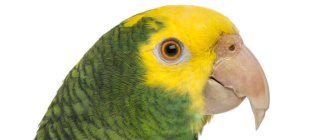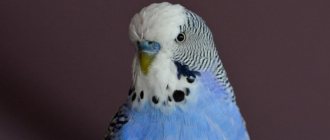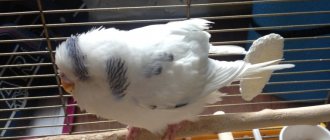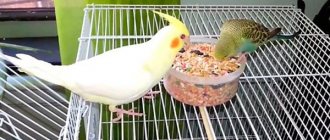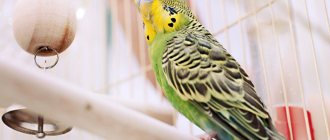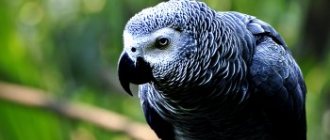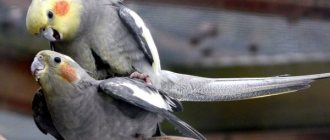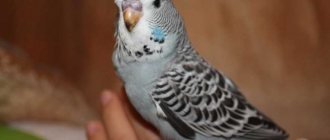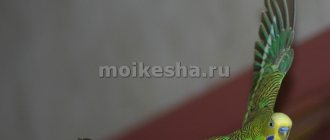Online magazine about parrots
Colors and patterns of budgies
We have translated and compiled for you a guide to the colors and patterns of budgerigars
Look
Popular article
Let's figure out how to choose a mate for a male or female budgie
2
Home › Reproduction
Female parrots reach sexual maturity at around 9 months of age. It is from this period that they are capable of mating and laying eggs. In general, female parrots lay eggs several times in their lives. It should be noted that in the wild this is only possible if there is a male.
Under domestic conditions, females can lay eggs without a male. You can determine that a pet is carrying an egg by the fact that it has begun the nesting period. It is accompanied by the preparation of a place for oviposition. To do this, the female chooses a certain place in the cage, in which she forms a nest from small sticks, twigs, feathers, pieces of paper, etc.
There are situations when it is difficult for a female to cope with the clutch on her own. In this article we will look at the reasons and discuss how to help a parrot lay an egg.
- For what reasons does the egg not come out?
- Symptoms of getting stuck
- What to do if the bird cannot cope on its own
- What to do if the egg is inside the oviduct
- What to do if oviduct prolapse occurs
- If the egg breaks inside
- Useful tips
- Conclusion
For what reasons does the egg not come out?
Typically, a healthy female budgerigar will lay eggs on her own without any problems.
In this case, the owner’s intervention is not required at all, since the processes of reproduction are dictated by instincts and are natural and physiological.
However, in some cases, the female may have problems laying eggs.
This happens quite rarely, but the inability to lay eggs is fraught with serious problems for the bird that can threaten its life and health.
Let us examine in more detail the main reasons why the female cannot lay an egg:
- Diseases . Infectious diseases, as well as exhaustion associated with poor and poor-quality nutrition, extremely weaken the bird, negatively affecting its reproductive abilities. Diseases can lead to the fact that the parrot simply does not have the physical strength to lay eggs. At the same time, pathogens of infectious diseases and parasites can cause inflammation of the oviduct, which disrupts its conductivity.
- Too frequent egg laying. An excess of natural protein in a bird’s diet leads to too frequent egg laying. This process is extremely exhausting for the bird, causing it to become exhausted and the muscles of the oviduct may weaken.
- Age of the bird. This problem most often affects too young or, on the contrary, old birds. In the former, this is due to the insufficient development of the oviduct, while in older birds, muscle tone and physical endurance are significantly lost.
- Pathologies of the reproductive system . Various congenital defects of the oviduct and other organs of the reproductive system, associated with anatomical and morphological changes, lead to the inability of the bird to lay eggs in principle. It is extremely rare.
- Egg size is too large. This problem is more common in young females. The underdevelopment of the reproductive organs means that the female cannot lay a large egg.
Couple communication and readiness to reproduce
Puberty in male budgerigars occurs at about 10 months, in females - a little later, after about the first year of life. The owners of an adult pair of birds can count on the appearance of offspring, but only if both the male and the female like each other. It’s not difficult to notice: the parrot will show off, coo touchingly near his friend and preen her feathers, and his neighbor will graciously accept such signs of attention. If the parrots' sympathy for each other is obvious, but they clearly do not plan to replenish the pair, you can try to push them to reproduce. To do this, experienced breeders use the following tricks:
- installation of a nesting house.
It will arouse interest in a female who is ready to have offspring, and she will begin to equip it and build a nest from fluff, twigs and blades of grass that she finds in the cage. Such attention to the house can be one of the sure signals that masonry is just around the corner; - increase in daylight hours.
Prolonged daylight hours can enhance the sexual activity of budgies, so it is often recommended to increase the illumination using special lamps. However, you can only act gradually: a sharp transition to long daylight hours can cause premature molting in birds; - vitamin and mineral supplements and changes in diet.
Females and males ready for reproduction sharply increase their appetite, so daily portions for them are increased. The daily menu also includes sources of calcium and vitamin D, including healthy balanced solutions to increase egg production.
When all favorable conditions for a couple are created, the chances of mating for parrots are very high. You can tell that birds are ready to breed by the fluffy plumage and raised tail of the female and the increased activity of the male. The mating season for budgerigars lasts 1–2 weeks with mating 1–2 times a day. During this period, it is extremely important to provide the birds with complete rest, a comfortable microclimate and protection from any stress and shock.
Symptoms of getting stuck
There are a number of characteristic signs by the presence of which it can be determined that a female has problems with egg laying:
- Enlarged lower abdomen . When the egg is gestating, it can be felt by palpating the bird's lower abdomen. It will be hard and significantly increased in volume. It is not permissible to apply strong pressure on the bird’s belly during the gestation period. This could result in serious injury.
- Muscle contractions. If it is impossible to lay an egg, the female is bothered by significant contractions in the lower abdomen, which can be felt tactilely and even visually.
- Behavior change . The bird spends a long time in a horizontal position at the bottom of the cage, refusing food and water, practically not reacting to the owner and external stimuli.
- Changes in bowel movements . A sick pet has a significantly reduced number of bowel movements. However, this increases their total volume.
- Changes in the cloaca. If there are problems associated with an egg getting stuck, the tissues around the pet's cloaca become hyperemic and swollen, which is accompanied by severe itching and discomfort for the pet.
In cases where an egg cannot be laid for a long time, systemic disturbances in the functioning of the body may occur. So, with this pathology, the liver and kidneys of the bird suffer. Due to disruption of their work, the pet may experience symptoms of general intoxication, which can lead to a significant deterioration in its condition or even lead to death.
Laying, incubation and emergence of chicks
Masonry.
If you can determine that the bird is actually carrying eggs, it is extremely important to adjust its diet. Females remove foods that can cause diarrhea from the menu so that the clutch develops naturally and without unnecessary complications. However, if the expectant mother is in poor health or does not feel very well, the veterinarian may recommend special medications to maintain vitality and the proper formation of the chicks. Budgerigars lay eggs approximately 10–18 days after mating. The quantity in one clutch is from 3 to 7 pieces. However, some of them may be unfertilized. This can be determined by holding each one up to the light: an embryo with a pattern of blood vessels should be visible in the egg. If nothing is visible inside, such eggs are simply removed from the clutch.
Incubation.
From the moment of laying until the chicks are born, about 3 weeks pass. All this time, the female practically does not leave the nesting house, turning the eggs over for uniform warming and incubation. She can leave the nest only from hunger or thirst or out of need. All this takes a minimum of time so that the masonry does not have time to cool. At the same time, males also often take care of their girlfriend and their offspring: they bring food and treats to the house and can even hatch the eggs themselves if the female has gone somewhere. However, there are frequent cases when the female abandons the clutch. Most often this occurs in young parrots during their first “pregnancy”, as well as during severe fright or stress. In such situations, owners interested in the appearance of offspring place eggs in an incubator; inexperienced owners can wait for the new mating season.
Birth.
Budgerigar chicks are born strictly in the order in which the female laid them, so there can be both chicks and eggs in the house at the same time. Then the mother and father take care of them for 1–2 months: the female feeds them with crop milk and warms them under the wings, and the male looks after them during those short periods when she is absent. By the end of the 2nd month, the babies leave the nest and independently get into the cage. Immediately after this, it is necessary to remove the house so that it does not cause the couple to need to reproduce again: for the full development of the next offspring, the mother needs to rest for at least several months.
What to do if the bird cannot cope on its own
If an egg gets stuck, you need to start helping your pet as soon as possible. Only a veterinarian can carry out qualified intervention in this process. In this regard, it is necessary to show the bird to a specialist.
However, the owner himself can provide primary assistance to improve the parrot’s condition before a veterinarian’s visit.
Below are several options for helping birds:
- Light massage. If the pet's general condition is relatively satisfactory, and he himself does not express his concern, then it is recommended to give a back massage. It should be done with light circular movements. Massage will increase blood flow and muscle contraction, which will significantly alleviate the pet’s condition.
- Injection of oil solutions into the cloaca. To facilitate the movement of the egg through the oviduct, experts recommend introducing a small volume (up to 2 ml) of oil into the cloaca. It is best to use regular vegetable oil or Vaseline oil. To do this, it must first be sterilized by boiling in a water bath, after which it is introduced into the cloaca using a previously disinfected pipette.
If the bird experiences bleeding or other heavy discharge from the cloaca, then this procedure is prohibited.
If these manipulations lead to the expected result and the egg is released, then immediately after this it is necessary to introduce a small amount of chlorhexidine or another antiseptic into the bird’s cloaca in order to prevent the occurrence of bacterial complications.
What to do if the egg is inside the oviduct
In difficult cases, when the first aid provided by the owner to his pet did not produce results, and the egg got stuck inside the oviduct, the help of a specialist is needed.
First, the veterinarian must determine the location of the egg and its position. This can be done either by palpation or by radiography. In addition, the cause of the pathology is determined.
As a rule, it is associated with insufficient muscle tone. In this case, the veterinarian injects the bird with oxytocin, a hormone that increases muscle contractions.
In difficult cases, surgery may be performed to remove the stuck egg.
Did your parrots have chicks?
Not really
If the egg breaks inside
The situation when an egg breaks inside a parrot's oviduct is extremely dangerous. The fact is that shell fragments can injure the bird and lead to a dangerous pathology.
If an egg breaks, the owner must carefully remove the shell from the oviduct . This can be done using previously disinfected tweezers. After this, a disinfectant solution (Furacilin, Miramistin or Chlorhexidine) is injected into the pet’s cloaca and, with a light massage of the back, they wait for the residues not removed by the owner to come out. When the remains of the shell and liquid have come out, it is recommended to reintroduce the antiseptic, after which it is necessary to give the bird complete rest.
In this case, subsequent consultation with a veterinarian is highly recommended. After examining the cloaca, he may prescribe special antibiotics to prevent the development of bacterial complications.
Video "Parrot Breeding"
Finally, a video talking about various aspects of parrot breeding and possible problems that can accompany this process!
Sorry, there are no surveys available at this time.
Was this article helpful?
Thank you for your opinion!
The article was useful. Please share the information with your friends.
Yes (100.00%)
No
X
Please write what is wrong and leave recommendations on the article
Cancel reply
Rate the benefit of the article: Rate the author ( 3 votes, average: 4.33 out of 5)
Discuss the article:

